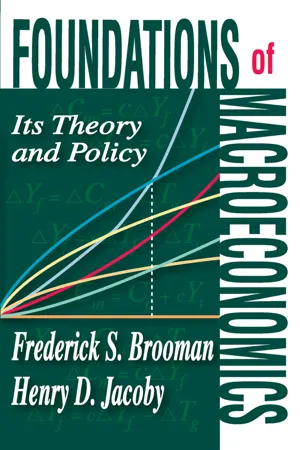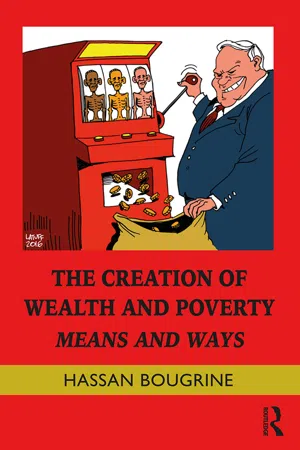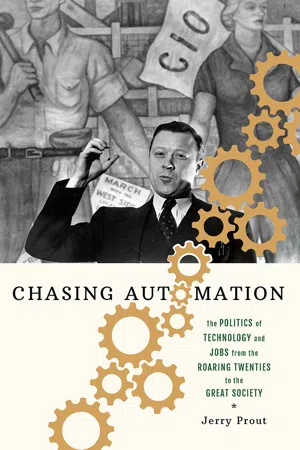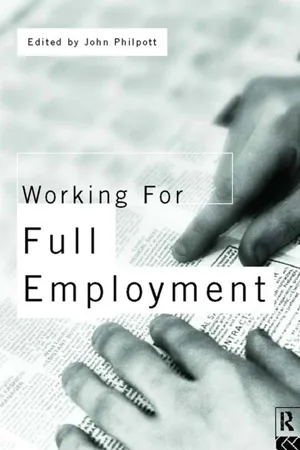Economics
Full Employment
Full employment refers to a situation where all available labor resources are being utilized in the economy. It does not mean zero unemployment, but rather a level of unemployment where the only people who are unemployed are those who are temporarily between jobs or transitioning to new ones. This level of unemployment is considered the natural rate of unemployment.
Written by Perlego with AI-assistance
Related key terms
Related key terms
1 of 4
Related key terms
1 of 3
7 Key excerpts on "Full Employment"
- eBook - ePub
Foundations of Macroeconomics
Its Theory and Policy
- Frederick S. Brooman(Author)
- 2017(Publication Date)
- Routledge(Publisher)
But if the buying and selling of labor is regarded more realistically as taking place in a large number of separate markets, the earlier definition of Full Employment becomes ambiguous. It might mean that employment is full only when the demand and supply of labor are equal in each separate market. This definition, however, is severely restrictive. In the economy as it exists in real life, changes in production methods and in the demand for products are constantly altering the pattern of demand for labor, and workers are responding by moving from old industries into new ones and from one place to another. The response normally takes time, so that in each separate labor market today’s demand is faced with yesterday’s supply. At any particular moment, the imperfect meshing of supplies and demands will cause some unemployment to exist, so that Full Employment in this restricted sense can never be reached.A second definition might be that Full Employment exists when the sum of demands in all markets equals the sum of supplies, even though there may be an excess of supply over demand (or demand over supply) in two or more of the separate markets for particular types of labor. If data were available on job vacancies, a comparison of the number of vacancies with the number of job-seekers would provide a rough guide to whether Full Employment exists or not. For the United States, however, no such vacancy statistics exist on a national leve1.13Still a third definition of Full Employment might be based on the relation between a high level of employment as an objective of macroeconomic policy and other national goals, such as price stability or a healthy balance of payments situation. Employment could be said to be full at that point where attempts to reduce unemployment still further would take an unacceptable toll in terms of other objectives of national policy. It is in this last sense that the term “Full Employment” is normally used in the United States, and the very nature of the definition makes it the subject of considerable dispute. Full Employment, thus defined, is therefore compatible with the existence of some unemployment, which is conventionally called “frictional” or “structural” to distinguish it from that which exists when employment is less than full. The latter type has been called 14 “involuntary” unemployment, on the ground that no possible effort on the part of jobless workers can find employment for all of them when the overall - eBook - ePub
The Creation of Wealth and Poverty
Means and Ways
- Hassan Bougrine(Author)
- 2016(Publication Date)
- Routledge(Publisher)
9 who sell the idea that the market does it best (see Bougrine, 2012). Hudson (2015: 180) refers to these ideas as neoliberal ‘junk economics’ that are “crafted to disable society’s defense mechanisms”.Martin Feldstein (2015) thinks that the US economy is already at Full Employment. To justify his claim, Feldstein (2015) wrote:The necessity of Full EmploymentAccelerating wage growth implies that the economy is now at a point at which increases in demand created by easier monetary policy or expansionary fiscal policy would not achieve a sustained rise in output and employment. Instead, this demand would be channeled into higher wages and price . . . [adding that] . . . since the beginning of this year, hourly earnings are up 3.3%, and in May alone rose at a 3.8% rate – a clear sign of Full Employment.So what’s there to worry about?When several of the recipients of the Orwell Award10 complained about the increasing use of doublespeak – words and phrases, which are intentionally designed to obscure the meaning of plain language, they probably were not thinking of “Full Employment”. Yet, the concept of “Full Employment” as used above refers to an economy in which there are officially 15 million persons who are willing to work but cannot find a job plus an additional 6 million people who are working part-time but would like to find a full-time job.11 The use of the concept of “Full Employment” in this sense is so prevalent among economists that in order to accurately describe reality, one is tempted to add another adjective: ‘true’ Full Employment cannot exist when there are so many unemployed people12 - eBook - ePub
Chasing Automation
The Politics of Technology and Jobs from the Roaring Twenties to the Great Society
- Jerry Prout(Author)
- 2022(Publication Date)
- Northern Illinois University Press(Publisher)
Beveridge freely acknowledged that the term was not to be taken literally. It was impossible, he said, to expect that “every man and woman in the country who is fit and free for work is employed productively on every working day of his or her working life.” Rather, he defined Full Employment as a state in which there were always more jobs available than there were unemployed individuals. He foreshadowed the vexing challenge for policymakers in the postwar era. Unemployment was inevitable, particularly as technology in the workplace advanced and, as it had done prior to the war, substituted for work previously done by humans. What proponents of Full Employment legislation sought was a system that compressed the time lag between losing a job and finding another. Achieving such required more planning, better anticipation, and improved coordination between public and private sectors than had existed prior to the war. 11 Beveridge defined Full Employment for England to mean that only 3 percent were unemployed at any one time. He considered this percentage acceptable because of what he termed “industrial friction.” In modern economies, and given the pace with which new machinery was transforming work, there would always be a mismatch between the jobs available and the workers seeking jobs. As one prominent economist, William Haber, noted in 1944, “Full Employment does not mean a job for everyone now included in the war-expanded labor force; nor does it mean absence of unemployment. In a dynamic society such as ours, with a labor force of nearly 60 million under peacetime conditions, it is possible to have some 3 million workers unemployed even under conditions of Full Employment. Full Employment does mean, however, a strong sustained demand for labor; an opportunity for productive work at all times.” In the United States, the legislative debate seemed comfortable with the overall framework Beveridge outlined - eBook - ePub
- Nicholas Deakin(Author)
- 2021(Publication Date)
- Routledge(Publisher)
Full Employment in this Summary means more vacant jobs than unemployed men. It means something else as well. If there were two million chronically unemployed men in Britain and 2¼ million vacant jobs which they could not or would not fill, there would be more vacant jobs than unemployed men, but to call this state of affairs Full Employment would be mockery. It is not enough to say that there must be more vacant jobs than unemployed—more or about as many It is also necessary to be sure that the number unemployed, or rather the duration of unemployment in the individual case, is not excessive. Full Employment, in any real sense, means that unemployment in the individual case need not last for a length of time exceeding that which can be covered by unemployment insurance without risk of demoralisation. Those who lose jobs must be able to find new jobs at fair wages within their capacity, without delay. This means that the demand for labour and the supply of labour are related qualitatively as well as quantitatively. The demand must not only be sufficient in total but must be directed with regard to the quality and the location of the labour that is available. The labour supply must be capable of following the changes of demand that are inseparable from technical advance.In so far as room is left for change and for freedom of movement from job to job, room is left for some unemployment. Full Employment, by its definition of more vacant jobs than unemployed men, clearly does not mean that there is literally no unemployment. It does not mean that every man and woman in the country who is fit and free for work is employed productively on every day of his or her working life; we have some unemployment even when our manpower is being strained to the utmost in total war. In every country with a variable climate there will be seasons when particular forms of work are impossible or difficult. In every progressive society there will be changes in the demand for labour, qualitatively if not quantitatively; there will be periods during which particular individuals can no longer be advantageously employed in their former occupations and may be unemployed till they find and fit themselves for fresh occupations. However high the demand for labour there will always be some frictional unemployment in a progressive society subject to seasons and having trade with other countries. - eBook - ePub
Macroeconomics
(With Study Guide CD-ROM)
- Jagdish Handa(Author)
- 2010(Publication Date)
- WSPC(Publisher)
equilibrium level of employment under certainty. To reiterate, the conditions for the existence of Full Employment are:• The absence of uncertainty about demand and prices. Full Employment would also occur in the presence of uncertainty if the expected prices and expected demand corresponded to the actual ones — so that there were no errors in expectations.• The absence of adjustment costs. Examples of adjustment costs are those of adjusting employment, output, and prices. Alternatively, if there are adjustment costs, as is normally quite likely, the economy's long-run responses captured in the analysis are only those after all the adjustments are over and the economy has again become stationary.• The absence of labor contracts. • Equilibrium in the labor market.Since the analysis of this chapter has assumed certainty and the absence of adjustment costs, the condition for Full Employment is met at its equilibrium employment level nLR *. To emphasise this property, we designate it as nf . Its corresponding equilibrium output level yLR * is the full-employment level of output yf .Our conclusions on the full-employment levels of output and employment are: • These levels are uniquely determined by the production function and labor supply. • They do not depend on aggregate demand, monetary, and fiscal policies, or the price level in the economy. • They shift only if there are shifts in the production function and/or in the labor supply function.7.8 The Role of Supply-Side Policies in Changing Full-Employment OutputAs we have seen above, positive shifts in the production function and the supply of labor increase the full- employment level of output. Policies that do so are called supply-side policies. - eBook - ePub
- John Philpott(Author)
- 2005(Publication Date)
- Routledge(Publisher)
We cannot be certain that this need to participate will necessarily be satisfied in a market economy. In the property market buildings can stand empty for years; in the market for consumer goods some of the stock has to be written off. If we treat labour as simply another commodity to be bought and sold, then it is human lives that will sometimes be written off and declared to be redundant. It is appropriate to use emotive language, because the issue here is one of feelings rather than calculation. We want the labour market to be humane in its treatment of individuals, as well as efficient, and we may fear that it is becoming less so. This is in part a matter of the way in which employers and employees choose to behave towards one another, but it is a matter of public policy as well.For many professional economists unemployment is the most important policy issue of all. We see our role as contributing to the solution of a social problem, not just making the economy more productive. We would be most reluctant to abandon the objective of Full Employment, because it points beyond economics to a goal which is not just increasing individual utility but also the cohesion of society as a whole.Setting Full Employment as a policy objective, even in the context of a market economy, makes it clear that society as a whole has an interest in the way that individuals are treated. It does involve the concept of a community and something which Beveridge called ‘public spirit’. We need, in the very different circumstances of today, to find the institutional setting within which that common purpose can be achieved.Clearly there is no way in which society can underwrite the continued existence of particular jobs or even occupations. Neither can there be a right to a job of ones own choosing at a wage one considers fair. A commitment to Full Employment will leave many individual ambitions unsatisfied and hopes disappointed. There will still be closures and redundancies, but perhaps we can find a better way of dealing with the consequences. Perhaps we can prevent people being too dependent on the continuation of a particular job and widen the opportunities they have to recover from misfortune when it hits them.If this is to be achieved then in practice something may well have to be given up in return. The recipe for Full Employment proposed by Keynes was in effect a ‘free lunch’. By making good the deficiency in demand everyone could be better off. If, however, unemployment is now a structural problem then it is unlikely that a painless cure can be found for it. One interpretation of the rise in unemployment is that society has given up the aim of Full Employment because it found the cost in terms of other objectives was too great. Perhaps no such conscious choice was ever actually made. If, however, we are now to make the deliberate choice that Full Employment is to be given priority then we need to know what else is being given up. To make a choice between aims we need to know the means that will be adopted. I turn therefore to the question of how a commitment to Full Employment in a market economy might actually be fulfilled. - eBook - ePub
- William H. Beveridge(Author)
- 2014(Publication Date)
- Routledge(Publisher)
263. Examination of each of two alternative approaches to the problem of Full Employment—by stabilization of total investment and by increasing the purchasing power of consumers—leads to the same conclusion. Each of these policies has elements of value, but each is incomplete; neither can stand by itself. Many of the measures proposed as part of these incomplete policies fall naturally into place as part of a larger adequate programme. It is necessary to increase consumption, but not only or mainly by increasing purchasing power in the hands of consumers. It is necessary to stabilize investment, but not at a level of inadequate consumption and under-employment, and not by leaving private investment to pursue an erratic course, while de-stabilizing public investment to fit that course.264. Full Employment means ensuring that outlay in total is sufficient. Only the State can ensure that. Full Employment at the rising standards of life made possible by technical progress means that the outlay is wisely directed. The State cannot escape ultimate responsibility for the general direction of outlay by reference to social priorities, however much it may be guided in its direction by the preferences expressed by citizens, in buying as well as in voting. The State cannot undertake the responsibility for Full Employment without full powers. It must adopt neither the consumption approach nor the investment approach exclusively, but must be free to adjust policy according to circumstances, over the whole range of possible subjects of spending.THE PROSPECTS OF SUCCESS265. If the State in Britain adopts the policy outlined here, can it make certain of success in conquering unemployment? The answer to this question has to be given in stages. There are some things of which the State can make certain. It can, by incurring expenditure, raise the total demand for labour to any desired point; that is to say the State can make certain that there is always a demand for labour quantitatively exceeding the supply of labour. This is the most important step required, and will make impossible such mass unemployment as occurred between the Wars. But it will not reduce unemployment to a harmless minimum, unless demand for and supply of labour are related qualitatively as well as quantitatively. This means either (a ) ensuring that the demand for labour, besides being sufficient in total, is in each of its main types stable, so that men are not thrown out of work by fluctuation in particular industries, or (b
Index pages curate the most relevant extracts from our library of academic textbooks. They’ve been created using an in-house natural language model (NLM), each adding context and meaning to key research topics.
Explore more topic indexes
Explore more topic indexes
1 of 6
Explore more topic indexes
1 of 4






